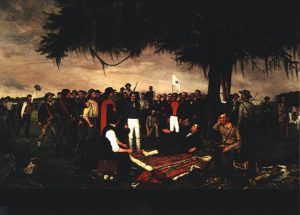1. Why is Deaf Smith important to Texas history?
Erastus “Deaf” Smith (1787-1837) is best known in Texas history as a scout, solider and spy during the Texas Revolution. He played a key role in the Battle of San Jacinto, in which Texas won its independence from Mexico on April 21, 1836.
At the battle, Smith led efforts to burn Vince’s Bridge, which cut off the Mexican retreat and may have helped with the capture of Mexican President Antonio Lopez de Santa Anna the day after the battle. But there is some controversy today about the precise location of the bridge.
According to an article in the Handbook of Texas Quarterly, the bridge was believed to be on Sims Bayou, which is deeper than Vince Bayou and harder to cross. Other accounts said the bridge was along Vince Bayou, which lies to the east of Sims Bayou. Both Sims Bayou and Vince Bayou are east of Houston and west of the San Jacinto Battleground. Both bayous feed into Buffalo Bayou.
In 1912, the San Jacinto Chapter of the Daughters of the Republic of Texas placed a historical marker at what was believed to be the site, which today is 505 Richey Street, beside Vince Bayou, in Pasadena. The Santa Anna capture site is northeast of this location, along Buffalo Bayou. It also has a historical marker.
2. Was Deaf Smith involved at the Battle of the Alamo?
Smith was involved at the Battle of the Alamo, which took place the previous month (March 1836). He was a messenger, and carried the famous letter written by the William B. Travis, the Alamo commander.

The Surrender of Santa Anna, William Henry Huddle (1886), on display in the Texas State Capitol. Deaf Smith cups his ear, on right.
3. How did Deaf Smith lose his hearing?
Smith lost his hearing due to a childhood disease. Like many with hearing problems, he would cup his hand to his ear to better hear what was being said. An example of him doing this is in the famous painting “The Surrender of Santa Anna” (1886), by William Henry Huddle, on display in the south foyer of the Texas State Capitol in Austin.
4. Was a Texas county named for Deaf Smith?
Yes. Deaf Smith County is in the Texas Panhandle, along the New Mexico border. According to the Texas Almanac, the county has a population of 18,952 and comprises 1,496 square miles. The county seat is Hereford. The primary business is agriculture.
